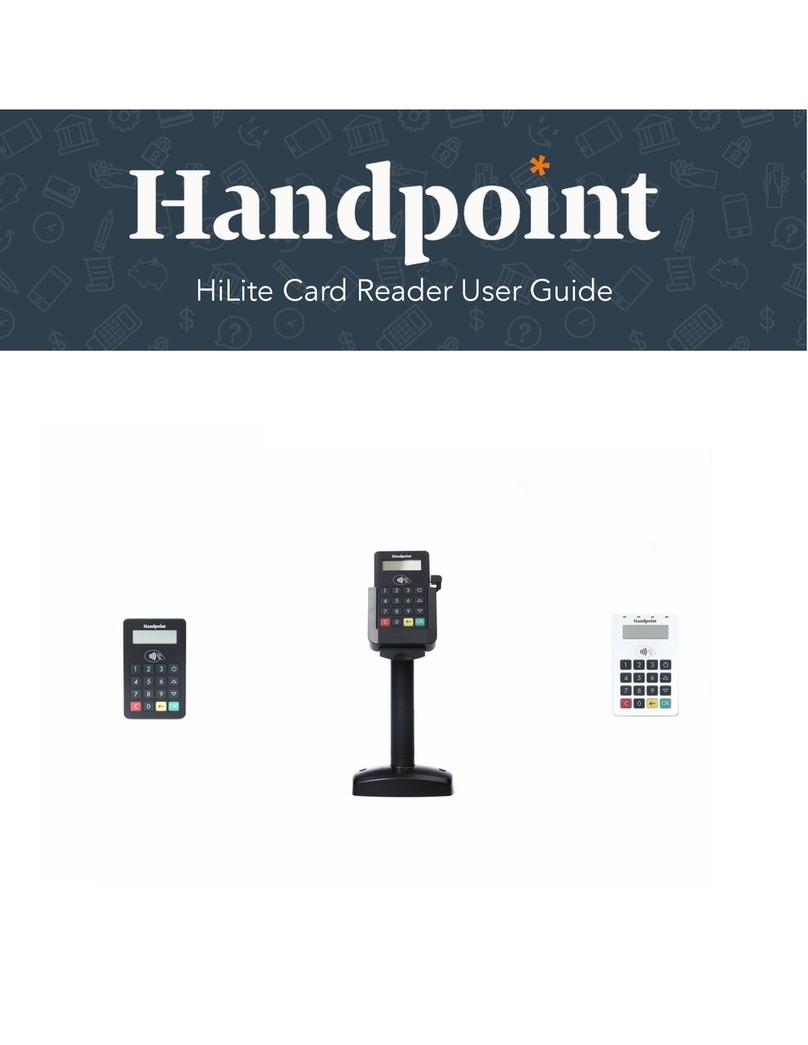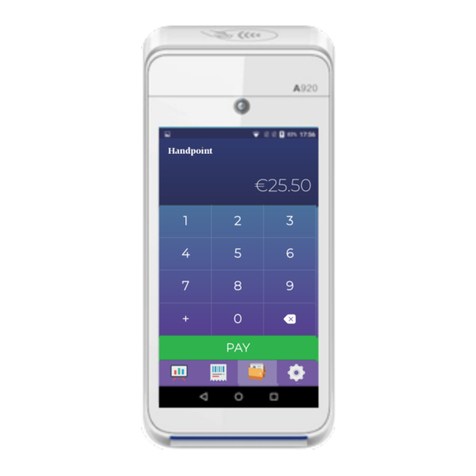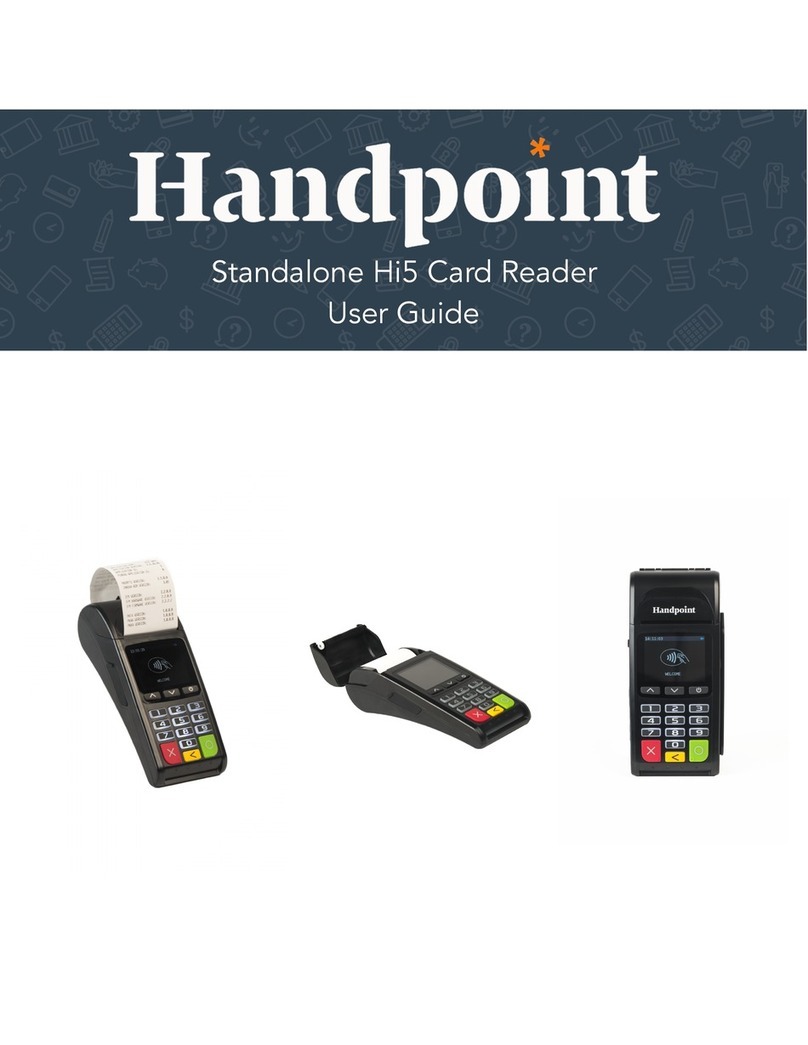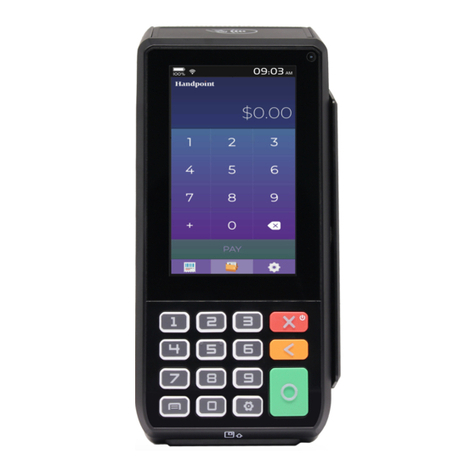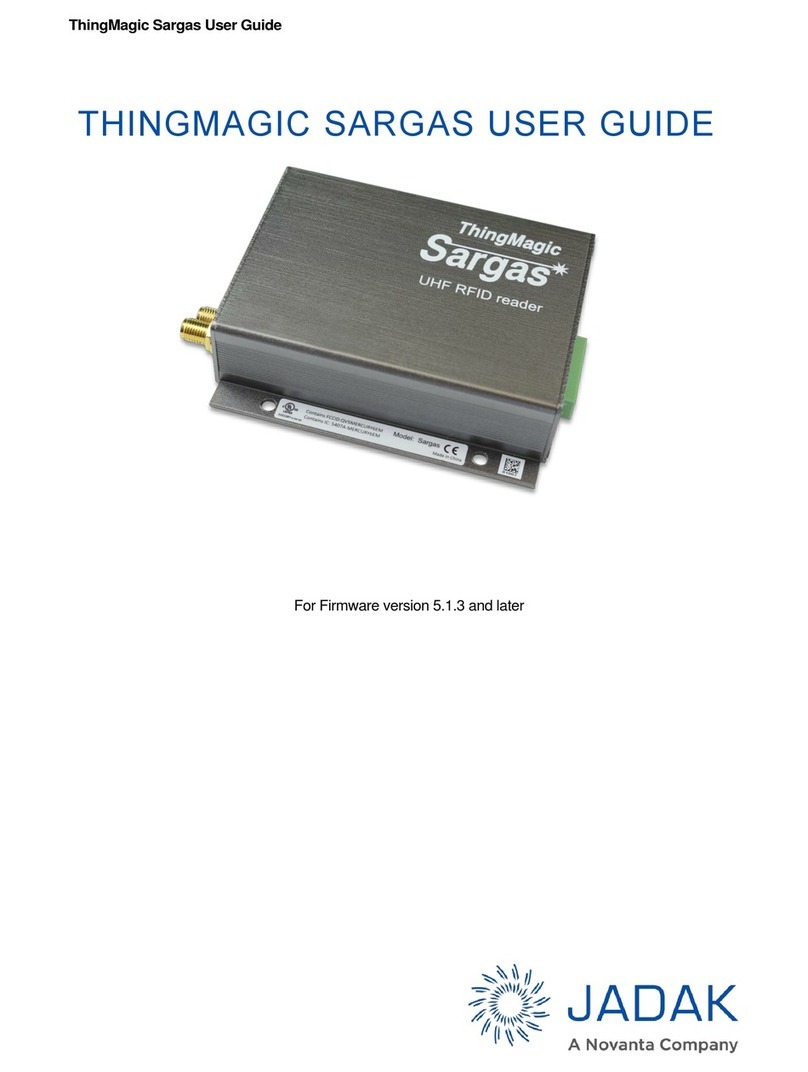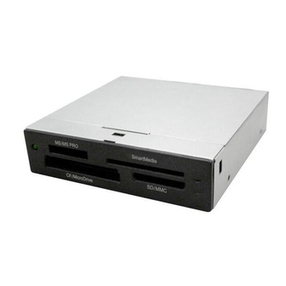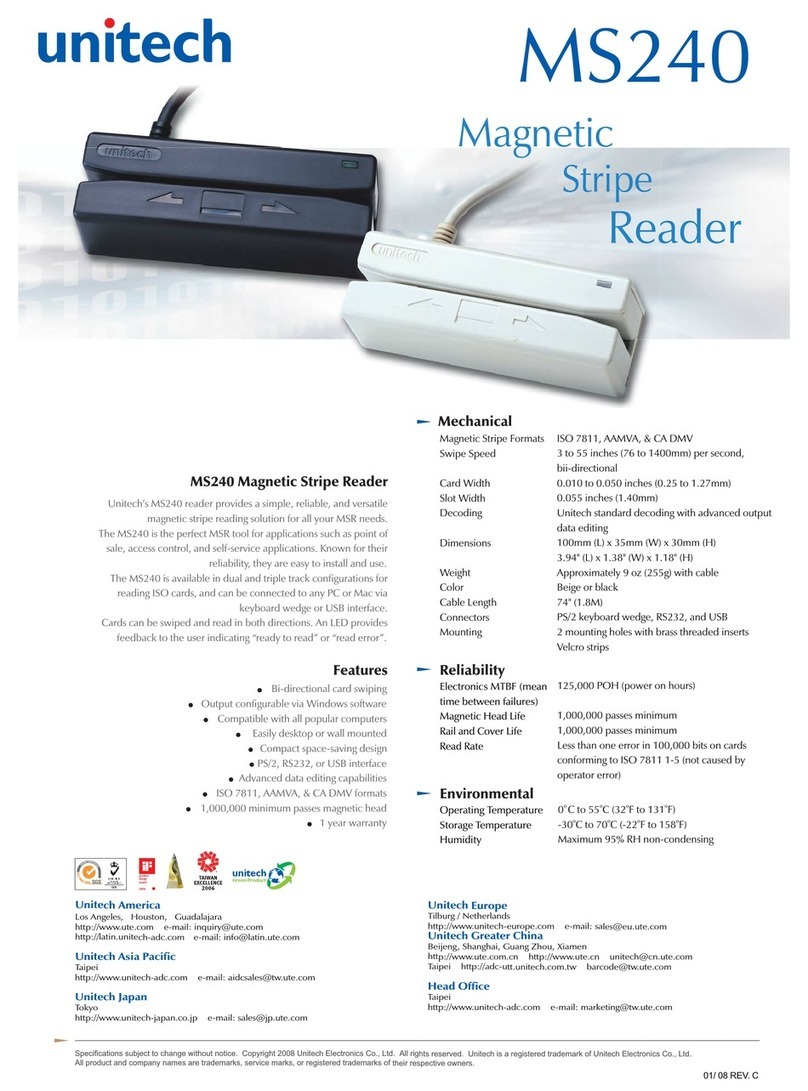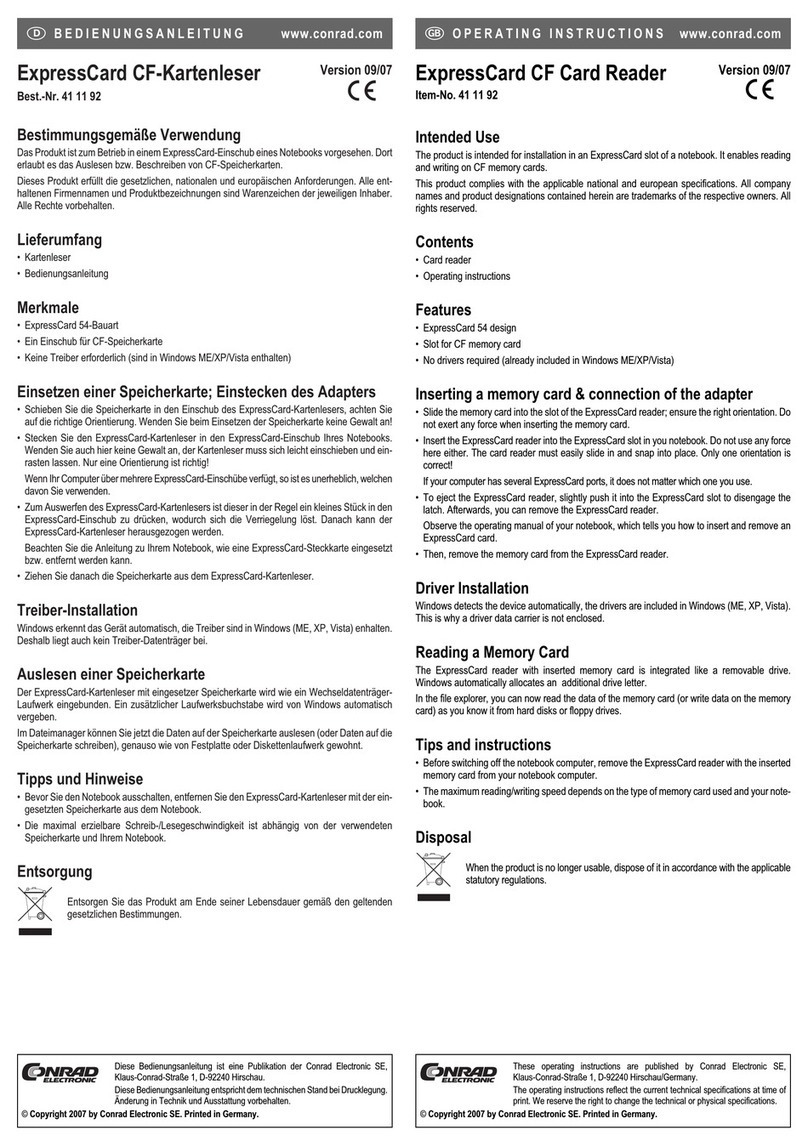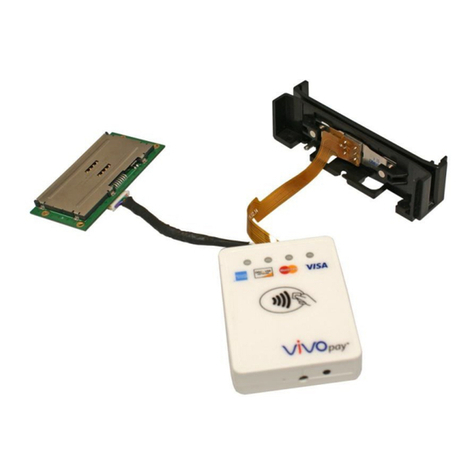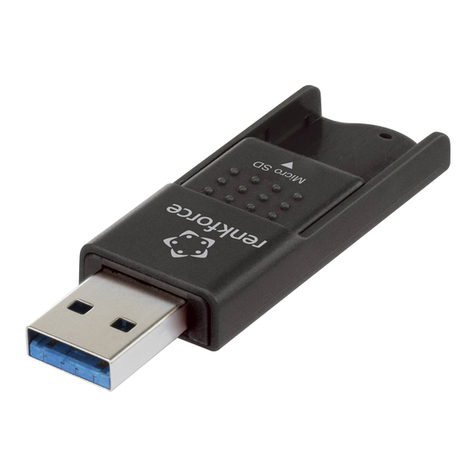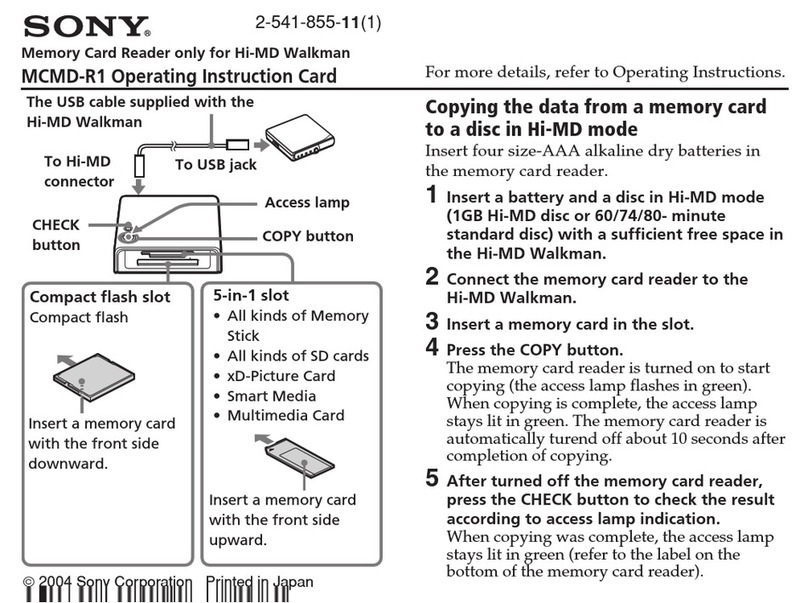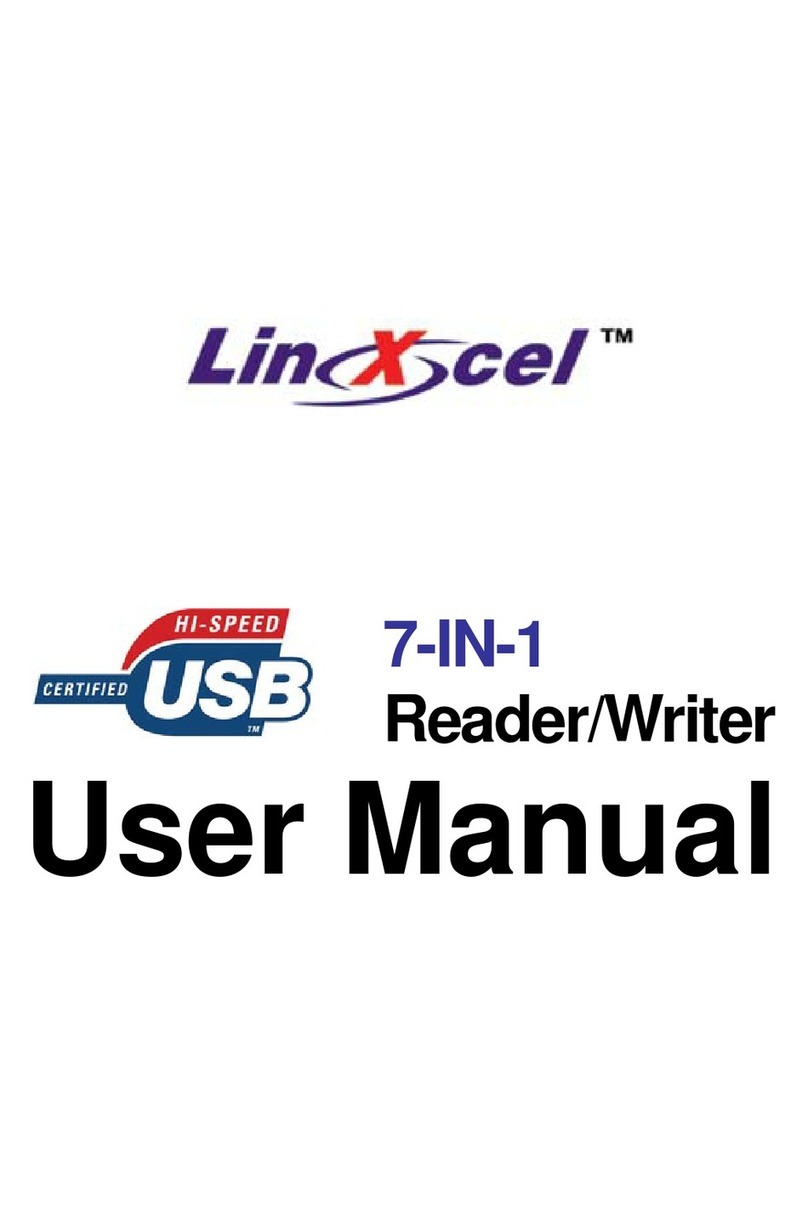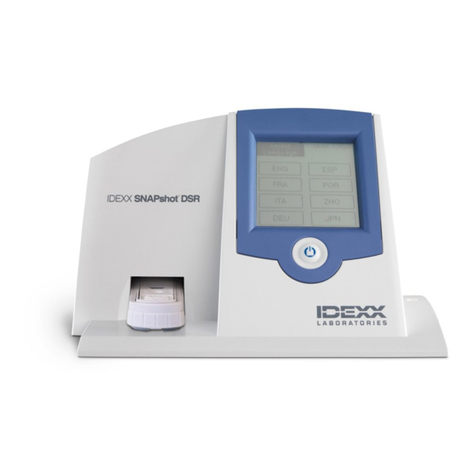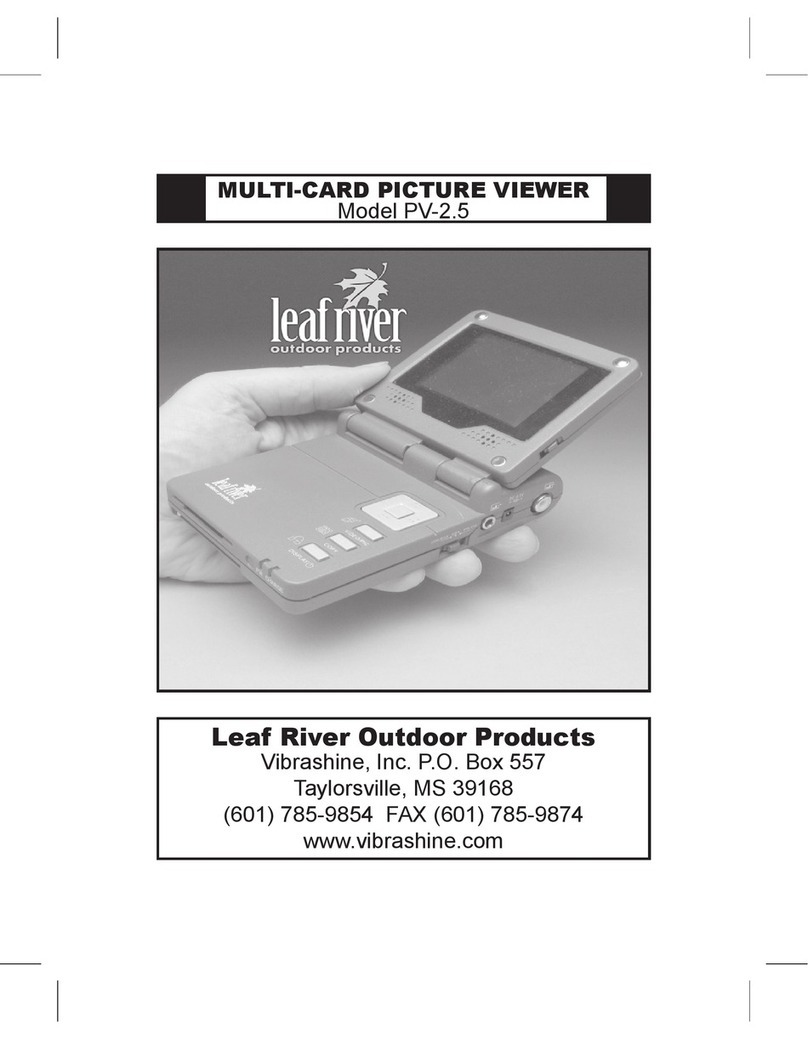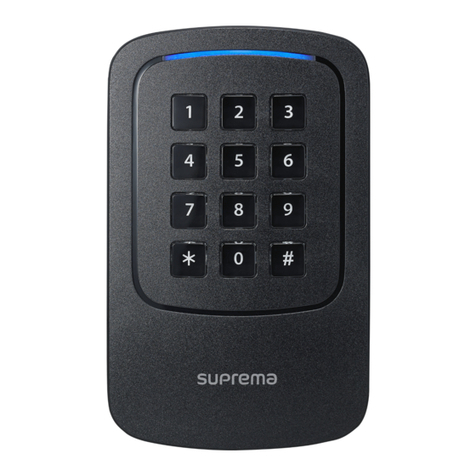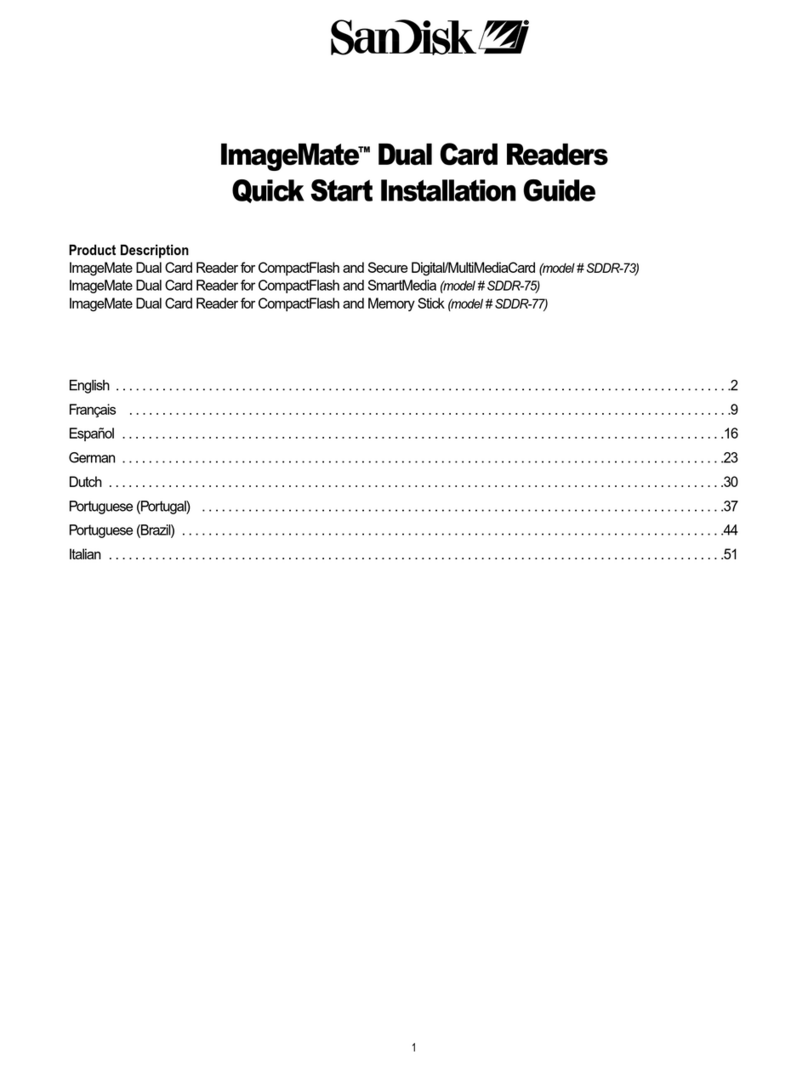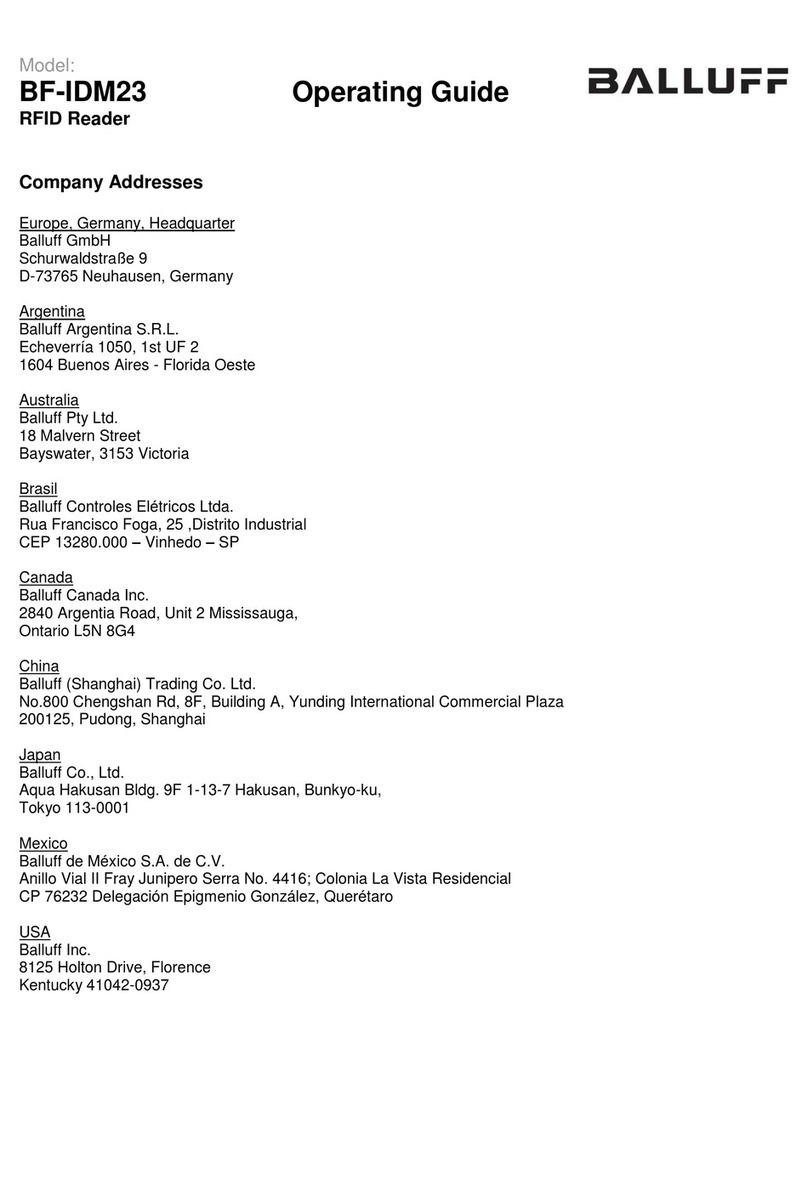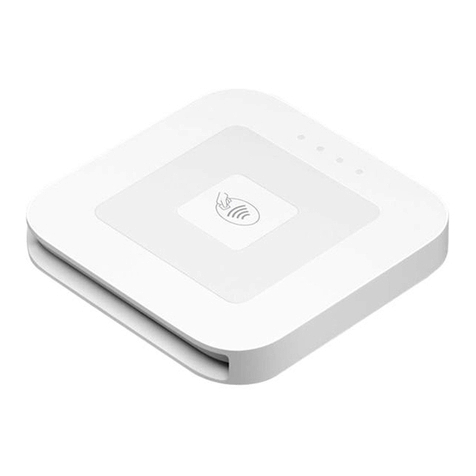Handpoint Hi5 User manual

!
Integrated Hi5 Card Reader
User Guide

Hi5 Card Reader User Guide
CONTENTS
1. Quick Getting Started Guide 3............................................................................
1.1. What’s in the Box? 3...................................................................................
1.2. Getting to Know Your Hi5 card reader 4............................................................
1.3. Get Started 6...........................................................................................
1.4. How it Works 7.........................................................................................
2. Hi5 card reader Specifications 8..........................................................................
2.1. Hardware Technical Specification 8.................................................................
2.2. Terminal Software and Configurations 8...........................................................
2.3. Security 9...............................................................................................
3. Hi5 card reader User Guide 9.............................................................................
3.1. Connecting Your Hi5 card reader 9..................................................................
3.2. Transactions 10.........................................................................................
3.2.1. Chip & Pin 10.....................................................................................
3.2.2. Chip & Signature 10.............................................................................
3.2.3. Fallback to Magnetic Stripe 11.................................................................
3.2.4. Magnetic Stripe 11...............................................................................
3.2.5. Pin Bypass 12.....................................................................................
3.2.6. Gratuity/Tips 12..................................................................................
3.2.7. Account Type Selection 13......................................................................
3.2.8. Cardholder Application Selection 14..........................................................
3.3. Administration Menu 16...............................................................................
3.4. View Information 17...................................................................................
3.5. Updating the Hi5 card reader 17....................................................................
4. Troubleshooting 19..........................................................................................
4.1. Troubleshooting issues 19.............................................................................
4.1.1. Communication Errors 19.......................................................................
4.1.2. Flash Corruption Errors 20......................................................................
4.2. Hi5 card reader Messages 21.........................................................................
4.2.1. Successful Transaction Messages 21...........................................................
!©2019 Handpoint1

4.2.2. Other Transaction Messages 22................................................................
4.2.3. Error Transaction Messages 23.................................................................
4.2.2. Updating Messages 26...........................................................................
4.2.3. Administration Messages 28....................................................................
5. Getting Support 29..........................................................................................
6. Glossary 31...................................................................................................
7. FAQs 32.......................................................................................................
!©2019 Handpoint2

1. QUICK GETTING STARTED GUIDE
This guide will help you get to know your Hi5 card reader and make your first transaction as an
integrated payment terminal.
1.1. WHAT’SIN THE BOX?
When you receive the box, check if the Handpoint seal is still intact. It should show you if
someone has opened the box before you. Inside the box you should find your Hi5 card reader
and a USB mini-B connector.
!©2019 Handpoint3

1.2. GETTING TO KNOW YOUR HI5 CARD READER
Here is your Hi5 card reader from all angles. The table below describes what you see.
"
"
"
"
"
#
Name
Description
1
Printer paper slot
Receipts print out from here. The printer paper should be inserted
with the paper sticking out of this slot before use.
2
Clock
Shows the time - hours : minutes : seconds
3
Charging port
The round port is for battery charging, using the included charger
4
USB port
The USB cable used for this port is for device programming and
debugging so not relevant for live card transactions
5
Up/down arrows
Move up and down the menus, then select by pressing the OK
button (see n. 10)
6
Cancel button
To cancel transactions when applicable, or other actions
7
NFC Status Lights
These lights indicate the status of a contactless transaction
!©2019 Handpoint4

8
EMV chip reader
Insert card with the chip into the slot (facing up)
9
Back button
To erase keyed numbers
10
OK button
To select or confirm actions
11
Power button
To turn on and off, hold button down for a couple of seconds and
follow commands
12
Magnetic stripe
reader
Swipe card with the magnetic stripe facing left
13
Icons
Here on the screen are icons which show battery life and Bluetooth
connection
!©2019 Handpoint5

1.3. GET STARTED
!
The first time you connect, you have to register the Hi5 card reader to the point of sale
application. Please follow the instructions in your POS app to connect and register. Each
version of the POS app does this differently.
The first transaction:
1. Make sure that the smartphone, computer or tablet you’re using with the Hi5 card
reader has Bluetooth turned on
2. Turn on the Hi5 card reader by pressing and holding [Power button] for a
couple of seconds
3. Pair the Hi5 card reader to the Bluetooth device
4. Follow the instructions on your POS app to register the Hi5 card reader
5. Wait until you see the Bluetooth icon (!) on the Hi5 card reader screen (see #13 in
section 1.2). When that icon appears, the Hi5 card reader is connected. This may take a
few seconds
6. Initiate a transaction in the POS app on the smartphone, computer or tablet
7. When the message “UPDATING READER” appears, the Hi5 card reader will start
downloading and installing the update. When the Hi5 card reader has finished, the
message “UPDATE COMPLETE” will appear
8. When the message “INSERT CARD” is displayed, insert the card in the EMV chip reader
(see #8 in section 1.2) with the chip facing up and towards the Hi5 card reader
9. Enter PIN using the keypad and press [OK button] (use [Back button] to
erase and then the keypad to re-enter pin if you make a mistake), or cancel by "
pressing [Cancel button]
10. When message “REMOVE CARD” appears, remove the card from the EMV chip reader
The POS app is responsible for providing the customer with the receipt created by the Hi5 card
reader.
!©2019 Handpoint6

1.4. HOW IT WORKS
This section shall demonstrate a short version of how the Handpoint solution technically works.
1. The mPOS/POS app downloaded on your device initiates a transaction on the Hi5 card
reader using Bluetooth
2. Customer inserts card and follows the directions on the Hi5 card reader screen
3. The Hi5 card reader sends the transaction information encrypted via Bluetooth to the
POS app
4. The POS app forwards the encrypted transaction information to the Handpoint
gateway via an internet connection which processes the transaction using your acquirer
5. The Handpoint gateway receives a response from the acquirer and forwards the
encrypted response to its internet connection
6. The POS app forwards the encrypted response to the Hi5 card reader via Bluetooth
7. The Hi5 card reader reads the response, finalises the transaction and sends a receipt to
the POS app
8. Customer removes card and the merchant retrieves the receipts from the Hi5 card
reader (keeping the first printed receipt which is the merchant copy and handing over
the second printed receipt which is the merchant copy) and provides the customer the
sale receipt through the POS app
!©2019 Handpoint7

2. HI5 CARD READER SPECIFICATIONS
Below are the technical specifications of the Hi5 card reader and information about the
software and configurations.
2.1. HARDWARE TECHNICAL SPECIFICATION
2.2. TERMINAL SOFTWARE AND CONFIGURATIONS
Handpoint develops the terminal software as well as the terminal configurations. The terminal
software communicates with your POS app (Point of Sale application) using Bluetooth.
The configuration is specific to each merchant and cannot be seen or modified by you. The
configurations are created by the Handpoint system and remotely pushed to your Hi5 card
reader.
In the case of a critical update, Handpoint can automatically and remotely push the latest
software or configuration version onto your Hi5 card reader.
Section 3.4 shows you how to find which software and configuration versions your Hi5 card
reader has.
Display
320 x 240 px TFT Color LCD
Card readers
Landing type smart card reader, triple track bi-directional
magnetic card reader
Battery
Rechargeable Li-ion 7.4V, 1300 mAh
Connectivity
Bluetooth 3.0 Class 2
Certifications
CE, FCC, PCI PTS 3.x, EMV Level 1 Contact, EMV Level 2
Contact, EMV Level 1 Contactless, VISA payWave, MasterCard
Contactless, American Express Expresspay, Discover Zip,
Apple® MFi
Dimensions (LxWxH), mm
172 x 76 x 49
Weight, g
320
Operational temperature
range
-10 °C to +40 °C / 5 to 90% RH
Storage temperature range
-15 °C to +50 °C / 5 to 90% RH
Power Supply
9V through power supply
!©2019 Handpoint8

2.3. SECURITY
All card information is encrypted using Triple Data Encryption Algorithm (3DES) with a Derived
Unique Key Per Transaction (DUKPT) key management process. Each transaction is encrypted
with 3DES using a unique key per transaction before being sent to the Handpoint gateway. The
Handpoint’s terminal software is certified as PCI Point-to-Point Encryption (P2PE) compliant.
For security reasons, it is essential that during a transaction the merchant and all employees
must not request a cardholder to divulge their PIN nor accept the PIN from the cardholder in
an oral or written manner.
3. HI5 CARD READER USER GUIDE
Here are further instructions how to use the different functions of your Hi5 card reader.
3.1. CONNECTING YOUR HI5 CARD READER
To be able to take payments your Hi5 card reader needs to be connected via Bluetooth to a
smartphone, computer or tablet with a POS app (Point of Sale application) that works with it.
The first time you connect you have to register the Hi5 card reader to your POS app. Please
follow the instructions from your POS app to connect and register. Each POS app does this
differently.
Connecting via Bluetooth:
11. Make sure that the smartphone, computer or tablet you’re using with the Hi5 card
reader has Bluetooth turned on
12. Turn on the Hi5 card reader by pressing and holding [Power button] for a
couple of seconds
13. Pair the Hi5 card reader to the Bluetooth device
14. Wait until you see the Bluetooth icon (!) on the Hi5 card reader screen (see #13 in
section 1.2). When that icon appears, the Hi5 card reader is connected
Your device and the Hi5 card reader should find each other every time as long as the Bluetooth
of your device is on. If you are prompted to enter a pairing code, enter “0000” as the code.
!©2019 Handpoint9

3.2. TRANSACTIONS
Transactions are initiated by the POS app on your smartphone, tablet or computer. Depending
on your acquirer and or agreement with your POS app provider, the following features may be
enabled."
3.2.1. Chip & Pin
The Hi5 card reader supports Chip & PIN cards. For Chip & PIN transactions use the EMV chip
reader (see #8 in section 1.2).
This is an example of what happens in a Chip & PIN transaction:
1. Transaction is initiated in the POS app on the smartphone, computer or tablet
2. When message “INSERT CARD” appears, insert card in the EMV chip reader (see #8 in
section 1.2) with the chip facing up and towards the Hi5 card reader"
3. Enter PIN using the keypad and press [OK button] (Use [Back button] to
erase and then use the keypad to re-enter pin if you make a mistake), or cancel by "
pressing [Cancel button]
4. When message “REMOVE CARD” appears, remove the card from the EMV chip reader
The merchant is responsible for providing the customer with the sales receipt from the POS
app and the card receipt from the Hi5 card reader printer."
3.2.2. Chip & Signature
The Hi5 card reader supports chip & signature cards. For chip & signature transactions use the
EMV chip reader.
This is an example of what happens in a chip & signature transaction:
1. Transaction is initiated in the POS app on the smartphone, computer or tablet
2. When message “INSERT CARD” appears, insert card in the EMV chip reader (see #8 in
section 1.2) with the chip facing up and towards the Hi5 card reader"
3. Confirm the amount by pressing [OK button] or cancel by pressing [Cancel
button]
The merchant is responsible for providing the customer with the sales receipt from the POS
app and the card receipt from the Hi5 card reader printer. The customer should sign the card
!©2019 Handpoint10

receipt on the signature line."
3.2.3. Fallback to Magnetic Stripe
If the Hi5 card reader cannot read the chip for some reason it will fallback to magnetic stripe.
The Hi5 card reader will prompt you to remove the card from the EMV chip reader (see #8 in
section 1.2) and swipe the card using the magnetic stripe reader (see #12 in section 1.2). The
Hi5 card reader might ask you to remove and insert the card into the EMV chip reader a couple
of times before falling back to magnetic stripe.
This is an example of what happens if a transaction falls back to magnetic stripe:
1. Transaction is initiated in the POS app on the smartphone, computer or tablet
2. When message “INSERT CARD” appears, insert card in the EMV chip reader (see #8 in
section 1.2) with the chip facing up and towards the Hi5 card reader
3. If the Hi5 card reader cannot read the chip message “REMOVE CARD” appears,
remove the card
4. When message “INSERT CARD” appears, insert card in the EMV chip reader
5. If the Hi5 card reader cannot read the chip message “REMOVE CARD” appears,
remove the card
6. When message “INSERT CARD” appears, insert card in the EMV chip reader
7. If the Hi5 card reader cannot read the chip message “REMOVE CARD” appears,
remove the card
8. When message “SWIPE CARD” appears, swipe card using the magnetic stripe reader
with the magnetic stripe facing to the front"
9. Confirm the amount by pressing [OK button] or cancel by pressing [Cancel
button]
The merchant is responsible for providing the customer with the sales receipt from the POS
app and the card receipt from the Hi5 card reader printer. The customer should sign the card
receipt on the signature line."
3.2.4. Magnetic Stripe
The Hi5 card reader supports cards that only have magnetic stripes. To do a transaction with a
magnetic stripe card use the magnetic stripe reader (see #12 in section 1.2). If the card has a
chip the Hi5 card reader will prompt you to use the EMV chip reader.
!©2019 Handpoint11

This is an example of what happens in a magnetic stripe transaction:
1. Transaction is initiated in the POS app on the smartphone, computer or tablet
2. When message “INSERT CARD” appears, swipe card using the magnetic stripe reader
with the magnetic stripe facing to the front"
3. Confirm the amount by pressing [OK button] or cancel by pressing [Cancel
button]
The merchant is responsible for providing the customer with the sales receipt from the POS
app, and the card receipt from the Hi5 card reader printer. The customer should sign the card
receipt on the signature line.
3.2.5. Pin Bypass
Pin bypass is only enabled for specific acquirers. Pin bypass allows the customer to choose if
they want to enter pin or not.
This is an example of what happens in a Chip & PIN transaction with pin bypass:
1. Transaction is initiated by the Hi5 card reader
2. When message “INSERT CARD” appears, insert card in the EMV chip reader (see #8 in
section 1.2) with the chip facing up and towards the Hi5 card reader"
3. To bypass the pin, press [OK button] instead of entering the pin (if pin bypass is not
enabled, the Hi5 card reader will show the message “NOT ALLOWED”)
4. When message “REMOVE CARD” appears, remove the card from the EMV chip reader
The merchant is responsible for providing the customer with the sales receipt from the POS
app and the card receipt from the Hi5 card reader printer."
3.2.6. Gratuity/Tips
To get the gratuity/tips feature, you have to ask for it especially from your card payment
provider. If you request to include gratuity/tips as an option during the transaction process, the
menu appears before pin entry where the customer can choose the amount.
Here is an example of the default gratuity/tip menu for a £20,00 sale:
!©2019 Handpoint12

This is what happens in a Chip & PIN transaction with gratuity/tips enabled:
1. Transaction is initiated in the POS app on the smartphone, computer, or tablet
2. When message “INSERT CARD” appears, insert card in the EMV chip reader (see #8 in
section 1.2) with the chip facing up and towards the Hi5 card reader
3. When the gratuity/tips menu appears, scroll menu using [Up arrow] and "
[Down arrow] to select how much you want to tip"
4. Press [OK button] to select tip amount, if you select “ENTER AMOUNT”:
a. Enter tip amount using the keypad (use [Back button] to erase and then
the keypad to re-enter amount if you make a mistake)"
b. Press [OK button]
5. Enter PIN using the keypad and press [OK button] (use [Back button] to
erase and then the keypad to re-enter pin if you make a mistake)
6. When message “REMOVE CARD” appears, remove the card from the EMV chip reader
The merchant is responsible for providing the customer with the sales receipt from the POS
app and the card receipt from the Hi5 card reader printer.
3.2.7. Account Type Selection
The account type selection is only enabled for specific acquirers and only appears for cards
that have multiple accounts. The menu appears before pin entry where the customer can
choose which account he wants to use for that transaction. "
Here is an example of menu items. Please note that they differ between acquirers and cards:
Menu item
No tip
18% £3,60
20% £4,00
25% £5,00
Enter amount
!©2019 Handpoint13

This is what happens in a Chip & PIN transaction with the account type selection enabled:
1. Transaction is initiated in the POS app on the smartphone, computer or tablet
2. When message “INSERT CARD” appears, insert card in the EMV chip reader (see #8 in
section 1.2) with the chip facing up and towards the Hi5 card reader
3. When the account type menu appears, scroll menu using [Up arrow] and "
[Down arrow] to find the right account type"
4. Press [OK button] to select account type"
5. Enter PIN using the keypad and press [OK button] (use [Back button] to
erase and then the keypad to re-enter pin if you make a mistake)
6. When message “REMOVE CARD” appears, remove the card from the EMV chip reader
The merchant is responsible for providing the customer with the sales receipt from the POS
app, and the card receipt from the Hi5 card reader printer.
3.2.8. Cardholder Application Selection
The cardholder app selection is only enabled for specific acquirers. A menu appears before PIN
entry where the customer can choose which payment application is used for that transaction.
Here is a list of menu items:
Menu item
Default
Savings
Cheque/debit
Credit
Menu item
Credit
Debit
Cash Benefit
Food Stamp
!©2019 Handpoint14

This is what happens in a Chip & PIN transaction with the cardholder point of sale application
selection enabled:
1. Transaction is initiated in the POS app on the smartphone, computer, or tablet
2. When message “INSERT CARD” appears, insert card in the EMV chip reader (see #8 in
section 1.2) with the chip facing up and towards the Hi5 card reader
3. When the Application Selection menu appears, scroll menu using [Up arrow]
and [Down arrow] to find the correct payment application"
4. Press [OK button] to select that payment application"
5. Enter PIN using the keypad and press [OK button] (use [Back button] to
erase and then the keypad to re-enter pin if you make a mistake)
6. When message “REMOVE CARD” appears, remove the card from the EMV chip reader
The merchant is responsible for providing the customer with the sales receipt from the POS
app, and the card receipt from the Hi5 card reader printer."
"
"
"
"
"
"
"
"
"
"
"
"
"
Gift Card
Private Label
!©2019 Handpoint15

3.3. ADMINISTRATION MENU
To access the administration menu:"
1. Press [Cancel button] and then (back button)"
2. Enter password: 746723 and press [OK button]
3. Scroll menu using [Up arrow] and [Down arrow]"
4. To go into sub-menus press [OK button]"
5. To select menu items press [OK button]"
6. To go out of menus press [Cancel button]
About each menu item:
Administration menu password:
746723
Menu item
Sub-menu
items
Description
Version info
-
Terminal software version e.g. mPOS v.1.7.1 (236)
Device type
Bluetooth
A connection type, supported - there should be star next
to Bluetooth which means it is selected.
Save and Reset
Select to save any changes you have made in this sub-
menu, the Hi5 card reader restarts.
Config
Reset flash
Resets to factory settings, next time you do a transaction
the Hi5 card reader will download and install the
software and configurations again.
Save and Reset
Select to save any changes you have made in this sub-
menu, the Hi5 card reader restarts.
Beep
Toggle
Turn beep on or off by selecting toggle.
Save and
Reset
-
Select to save any changes you have made in the
administration menu, the Hi5 card reader restarts.
!©2019 Handpoint16

3.4. VIEW INFORMATION
To view information about your Hi5 card reader:"
1. Press [Cancel button] then [Up arrow] on the keypad
2. Scroll to see information using [Up arrow] and [Down arrow]"
3. To exit, either wait a couple of seconds or press [Cancel button]
About the information you see:
3.5. UPDATING THE HI5 CARD READER
It depends on the POS app (Point of Sale application) if you can update the Hi5 card reader
manually. Then the update is initiated through the POS app on your smartphone, computer or
tablet.
Handpoint may also push updates automatically and remotely to your Hi5 card reader."
This is what happens when Handpoint pushes a non-critical update to your Hi5 card reader:
1. Transaction is initiated by the Hi5 card reader
Menu item
Description
SN
Serial number of Hi5 card reader e.g. 1916009227
mPOS
Terminal software version e.g. v.10.1.2
TAG
Compilation type e.g. HI5
COMs
Type of connection used e.g. Bluetooth
BT
The name of your Bluetooth connection e.g. PP0615009227
Pass
Bluetooth password e.g. 0000
Addr
MAC address of the bluetooth module
Config
Configuration version e.g. 2
Flash
This has information about the flash memory, used by Handpoint
quality assurance
EMV
EMV version e.g. 2.00 03 210514
Pinutil
Software library version, such as for communications
PayEngine
Software library version (regarding EMV programming)
!©2019 Handpoint17

2. When message “INSERT CARD”appears, insert card in the EMV chip reader (see #8 in
section 1.2) with the chip facing up and towards the Hi5 card reader
3. Enter PIN using the keypad and press [OK button] (use [Back button] to
erase and then the keypad to re-enter pin if you make a mistake)
4. When message “REMOVE CARD” appears, remove the card from the EMV chip reader
5. The message “UPDATING READER” appears and the Hi5 card reader starts
downloading and installing the update, this only takes a couple of seconds. When the
Hi5 card reader has finished the message “UPDATE COMPLETE” appears.
This is what happens when Handpoint pushes a critical update to your Hi5 card reader:
1. Transaction is initiated by the Hi5 card reader
2. When message “INSERT CARD” appears, insert card in the EMV chip reader (see #8 in
section 1.2) with the chip facing up and towards the Hi5 card reader"
3. Enter PIN using the keypad and press [OK button] (use [Back button] to
erase and then the keypad to re-enter pin if you make a mistake)
4. The message “TRANS. DECLINED“ appears will appear on the screen
5. When message “REMOVE CARD” appears, remove the card from the EMV chip reader
6. The message “UPDATING READER” appears and the Hi5 card reader starts
downloading and installing the update which only takes a couple of seconds. When the
Hi5 card reader has finished the message “UPDATE COMPLETE” appears
7. After the Hi5 card reader has finished updating, you can initiate the transaction again to
charge the customer.
!©2019 Handpoint18

4. TROUBLESHOOTING
In this section are tools to help you troubleshoot. It includes instructions on how to
troubleshoot communication errors between the Hi5 card reader and the backend system.
There is also a section with tables with some of the possible messages that can appear on your
Hi5 card reader. If you are having a problem, you can try searching these tables for the
message and see what you can do.
4.1. TROUBLESHOOTING ISSUES
Here are some instructions to help you troubleshoot issues.
4.1.1. Communication Errors
If the Hi5 card reader shows a communication error message it means that the Hi5 card reader
detected a communication failure."Here is what you can do to try to troubleshoot it:
Firstly, try to turn the Hi5 card reader off and on again:
1. Make sure that the smartphone, computer, or tablet you’re using with the Hi5 card
reader has Bluetooth turned on
2. Turn off the Hi5 card reader by pressing and holding [Power button] for a "
"
couple of seconds and pressing [OK button]
3. Turn the Hi5 card reader back on by pressing and holding [Power button] for a
couple of seconds
4. Wait for the Hi5 card reader to connect or follow the connection instruction from your
POS app. When you see the Bluetooth icon (!) on the Hi5 card reader screen (see #2 in
section 1.2) the Hi5 card reader is connected to the POS app
5. Try to initiate a transaction again.
Secondly, disconnect the Bluetooth connection and reconnect
1. Make sure that the smartphone, computer, or tablet you’re using with the Hi5 card
reader has Bluetooth turned on
2. Look for the Bluetooth name (BT menu item in section 3.4) in your smartphone,
computer, or tablet’s Bluetooth list and disconnect according to the directions of your
device
3. Reconnect the Hi5 card reader according to the directions of your device
!©2019 Handpoint19
Other manuals for Hi5
1
Table of contents
Other Handpoint Card Reader manuals
